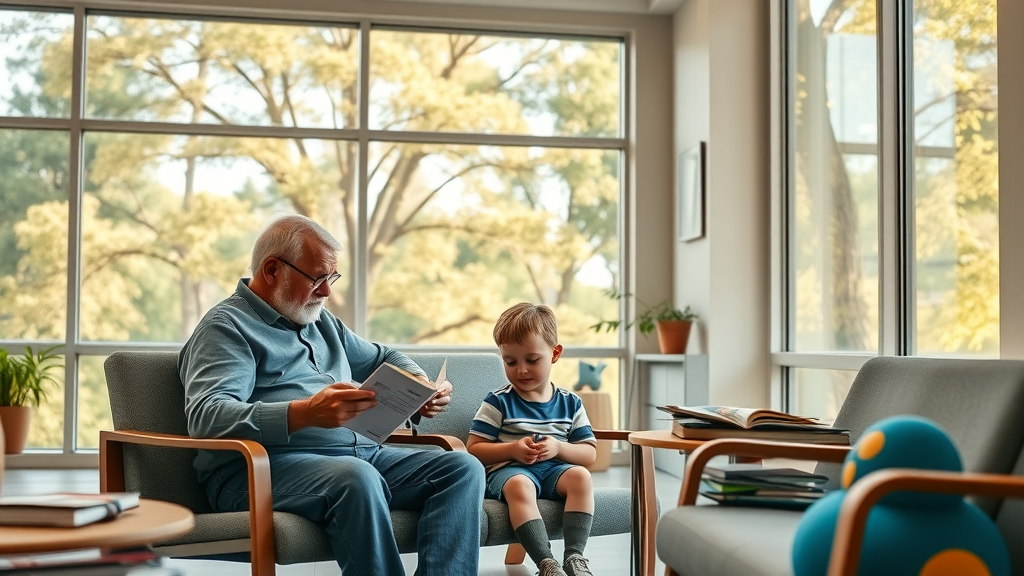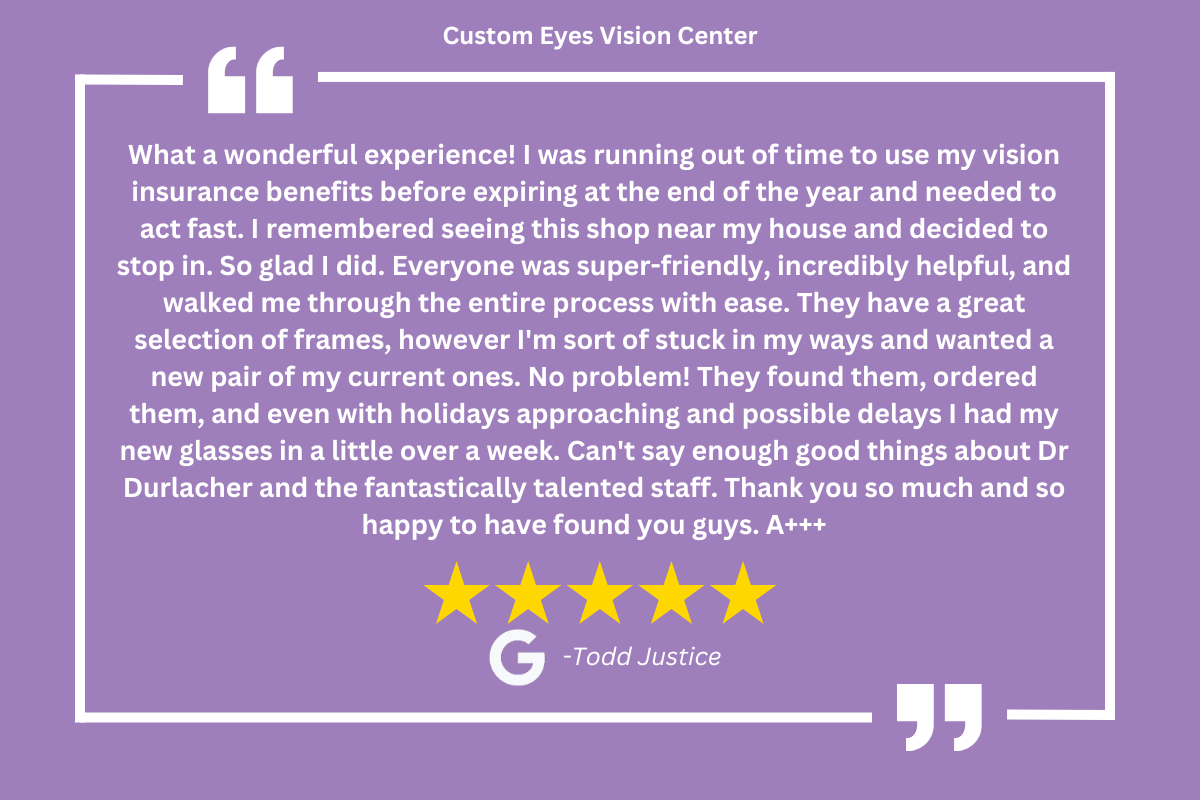
Custom Eyes Vision Center
📍 Address: 257 Lee Dr Suite Q, Baton Rouge, LA 70808, USA
📞 Phone: +1 225-819-0120
🌐 Website: http://customeyesbr.com/
★★★★★
Rating:4.9
For Baton Rouge Residents, Quality Eye Care Matters More Than Ever
In a world where screens are everywhere and daily demands never end, eye health is more than a routine—it’s essential to living life fully. Many realize only after discomfort or a sudden vision change how much we depend on clear, healthy eyesight to work, connect, and thrive. The stakes are high: unchecked eye conditions can escalate or go unnoticed for years, quietly stealing away the clarity needed for school, driving, work, and everyday joys. That’s why the search for a trustworthy, comprehensive eye care provider is more critical than ever for families and individuals in Baton Rouge.
The challenge, though, lies not just in scheduling an eye exam, but in finding a vision center that sees patients as more than a chart or a number. Many people experience hesitancy or confusion about when and why to seek professional eye care beyond new glasses. Yet, regular, professional assessment can detect subtle issues early—before they turn into more serious conditions. Your family deserves a dedicated, compassionate approach that blends modern technology with a deep understanding of patient concerns, all in an environment that respects your time and your well-being. This article explores why such comprehensive care matters, dispels common myths, and uncovers why Custom Eyes Vision Center Baton Rouge has become a trusted resource for those seeking not just better vision but better quality of life.

The Value of Comprehensive Eye Exams and Personalized Vision Solutions
Comprehensive eye exams are not simply about updating a glasses prescription—they are a cornerstone of lifelong eye health. At every age, clear eyesight underpins education, safety, work performance, and social confidence, making it one of the most influential components of overall wellness. Eye exams go far beyond vision tests; they serve as critical screenings for conditions like glaucoma, cataracts, and other diseases that can silently threaten sight. What’s often overlooked is that many of these conditions show no symptoms until the damage is advanced. Regular, thorough assessments using the latest diagnostic technology can catch these concerns early, offering patients the best chance at maintaining healthy vision throughout their lives.
Baton Rouge families face busy schedules—finding time for healthcare can be a challenge. That’s why tailored vision solutions, including fittings for contact lenses, myopia control for children, and therapies for dry eye disease, have become invaluable. A patient-centered approach ensures not only that vision corrections are accurate but that each person’s unique lifestyle and concerns are addressed. Ignoring these proactive steps can lead to missed diagnoses or ineffective solutions—leaving families struggling with avoidable discomfort or vision loss. The commitment to comprehensive, compassionate care is what empowers local residents to enjoy the clarity and confidence they need every day.

How Thoughtful Eye Care in Baton Rouge Changes Lives Every Day
Custom Eyes Vision Center Baton Rouge stands out as a valuable contributor in the field of family eye care, providing an approach rooted in professionalism, warmth, and technical expertise. Their philosophy recognizes that exceptional eye care is a blend of detailed assessment, open communication, and adaptability to the needs of all ages. With services extending from a child’s first eye exam to vigilant screenings for seniors, they highlight how comprehensive care can have lifelong benefits. Beyond detecting early signs of diseases, regular checkups at a reputable center foster healthy visual development, support educational achievement, and promote day-to-day comfort.
For adults, the comfort of knowing their eyewear choices are professionally guided—rather than chosen from generic online retailers—means greater confidence in both function and fit. The importance of well-fitted lenses, accurate prescriptions, and access to dry eye therapy or myopia control can’t be overstated. Custom Eyes Vision Center recognizes eyewear as more than a commodity; it’s a daily tool that shapes how patients interact with their world. This personalized, technology-driven service model not only addresses current vision needs but offers peace of mind that future concerns will be managed proactively and effectively. Baton Rouge residents benefit from these tangible improvements: better vision, less discomfort, and the reassurance that their eye health is diligently protected.
Family Eye Care from Infancy to Senior Years: What Truly Sets Comprehensive Providers Apart
Not all eye care centers deliver the same breadth of services or family-focused philosophy. In Baton Rouge, a provider who embraces every age group—responding to the distinct needs of toddlers, teens, working adults, and seniors—addresses a significant community need. Many practices segment populations or prioritize speed over depth. By contrast, Custom Eyes Vision Center’s commitment to complete family care ensures no one is overlooked, from a child nervous at their first eye exam to a grandparent seeking help for age-related conditions.
With modern diagnostic technology and a comfortable clinic environment, families experience care that is both thorough and reassuring. This approach goes beyond simply prescribing glasses or contact lenses; it builds long-term relationships, trust, and understanding. By tracking changes in eye health over time, comprehensive providers can anticipate and address issues early, dramatically reducing the risk of irreversible damage. In a region as dynamic and diverse as Baton Rouge, such attentive, customized care is transformative—offering peace of mind as well as functional, everyday benefits.
Affordable Eyecare in Baton Rouge: Why Access Matters
For many families, the greatest barrier to proper vision care is affordability. Baton Rouge is home to people from all backgrounds, and offering eye exams, eyeglasses, and therapy at accessible price points fundamentally changes what’s possible for the community. Custom Eyes Vision Center’s deep commitment to affordability means that clear sight isn’t a luxury—it's a right for every resident. This is especially impactful for parents of young children or seniors on fixed incomes, ensuring they are not forced to delay critical interventions due to cost.

Accessible care also builds community trust and loyalty. When locals know that professional, high-quality service is within reach, they are more likely to take proactive steps to safeguard their eye health. Comprehensive exams become a routine part of wellness—not an emergency response. Ultimately, prioritizing affordability expresses a core belief: everyone deserves the opportunity to see clearly and live comfortably, regardless of financial circumstance.
Empowering Patients: Education, Convenience, and Lasting Outcomes in Eye Health
Empowering patients with knowledge is another signature strength among leading eyecare centers. Through thoughtful blog posts and direct conversations, Custom Eyes Vision Center educates patients on topics like dry eye therapy, digital eye strain, and the critical limitations of online eyewear shopping. These resources demystify common vision challenges and help patients make informed decisions about treatments, lens technology, and preventative care. Education isn’t limited to brochures—it’s woven into every appointment and interaction so that each visitor leaves feeling understood and equipped.
Convenience also shapes the overall experience. With organized scheduling and a welcoming environment, patients find eye care that fits seamlessly into their lives—even amidst packed school calendars or work commitments. Optometrists guide lens fittings, address eye discomfort, and work collaboratively to create sustainable solutions. This holistic, informed approach fosters not just short-term improvement but lifelong habits that protect and preserve vision over decades.
Custom Eyes Vision Center’s Philosophy: Personalized, Compassionate Vision Care
A close look at Custom Eyes Vision Center reveals a philosophy that elevates patient care beyond the transactional. Their approach centers on compassion, empathy, and genuine interest in each patient’s story and aspirations. Professional optometrists emphasize comfort, convenience, and education at every step, ensuring each visit is tailored to individual needs and concerns. The atmosphere is intentionally welcoming so even those anxious about examinations feel confident and at ease.
Investing in the latest technology for diagnostics and management, the center positions itself not just as a provider but as a community partner in health and wellness. Their mission is clear: deliver eye care that fits busy schedules, attends to every family member, and supports long-term vision health. This commitment to quality and affordability is matched by their belief that every patient deserves to be heard, respected, and empowered. Through these guiding values, Custom Eyes Vision Center has become a trusted resource not just for vision correction, but for holistic, lifelong eye wellness in Baton Rouge.
What Baton Rouge Residents Experience with Custom Eyes Vision Center
For community members who want to understand what truly differentiates family-focused vision care, the experiences of real patients provide invaluable insight. Here is a compelling testimonial drawn from published reviews that illustrates the kind of impact and reassurance Baton Rouge locals find when they choose Custom Eyes Vision Center for their eye health needs:

Feedback from the community consistently highlights comfort, patience, professionalism, and genuine care—qualities that transform a simple appointment into a valued partnership. Those who act on the importance of proactive eye care with a trusted team experience not just sharper vision, but greater confidence and long-term wellness. For Baton Rouge families, these positive, reassuring experiences show the benefits waiting for those who prioritize comprehensive, personalized eye health.
Why Trusting Your Vision to Custom Eyes Vision Center Baton Rouge Makes a Lasting Difference
In a city known for its vibrant culture and active families, customized eye care is a thread that weaves through everyday well-being, learning, and connection. The science is clear: regular, professional assessments and tailored treatment not only safeguard vision but prevent small problems from escalating into life-altering issues. The role of Custom Eyes Vision Center Baton Rouge in this landscape is that of a steadfast expert—bringing advanced technology and heartfelt compassion to every patient encounter. Their philosophy and approach have set a high bar for what family eye care can be, making them a vital contributor to the community. For residents seeking clarity, comfort, and confidence, making vision a priority is an investment in all the moments and milestones that matter most.
Contact the Experts at Custom Eyes Vision Center
If you’d like to learn more about how eye care in Baton Rouge could benefit your vision and overall wellness, contact the team at Custom Eyes Vision Center.
📍 Address: 257 Lee Dr Suite Q, Baton Rouge, LA 70808, USA
📞 Phone: +1 225-819-0120
🌐 Website: http://customeyesbr.com/
Custom Eyes Vision Center Location and Hours
🕒 Hours of Operation:
📅 Monday: 10:00 AM – 5:00 PM
📅 Tuesday: 10:00 AM – 5:00 PM
📅 Wednesday: 10:00 AM – 5:00 PM
📅 Thursday: 10:00 AM – 5:00 PM
📅 Friday: 10:00 AM – 5:00 PM
📅 Saturday: ❌ Closed
📅 Sunday: ❌ Closed

 Add Row
Add Row  Add
Add 


